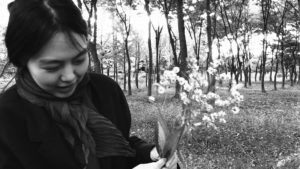Not So Quiet on the Western Front
An anti-war film denouncing the valorization of senseless violence, 'All Quiet on the Western Front' is (unfortunately) all too relevant in 2022.


The Novelist’s Film is one of three films by the South Korean filmmaker Hong Sang-soo to be released stateside this year. As one of the most prolific filmmakers currently alive (having released fifteen films since 2013, nearly 30 since 1996), a multi-release year is not uncommon for Hong. The prolific director has maintained such an impressive rate of filmic output by accomplishing what the great luminaries of the French New Wave believed to be a necessary philosophy for the artistic integrity of cinema: returning the means of production to the hands of the auteurs and abolishing the confines of time and money. Production, craft, and profit are hardly complementary ingredients, but Hong is able to make movies that align with his artistic and personal vision by vesting control in a small number of collaborators. Aside from the cast of actors (eight are credited), the film credits Kim Min-hee (Hong’s recurring collaborator and partner) as production manager, Seo Ji-hoon for sound, and Hong Sang-soo as director, writer, cinematographer, editor, producer, and musical composer. As a screenwriter, Hong rarely prepares scenes more than a day in advance of shooting, which lends his films a uniquely 1:1 parity with reality, dialogue-heavy without feeling scripted.
Hong has refined a specific style of filmmaking that reflects his own life as a filmmaker while reframing the domestic realism of human relationships and quotidien coincidences as surreal, ethereal, galvanizing, and tender. The distinctions between off-screen reality and the narratives within his films become so blurred that a viewer is left with the impression that, to the director, cinema and life are practically indistinguishable, that the uniquely expressive soul of cinema is the same nuance that we experience in everyday interactions. The film is comprised of a series of meetings, interactions, and conversations that may seem cyclical, but Hong’s gentle care imbues each scenario with a sense of magic that transcends the trivial.
The plot of The Novelist’s Film evokes the genesis of the movie itself, presented through the pace, staging, and happenstance that is indicative of Hong’s body of work. Largely taking place over one afternoon, a successful novelist suffering from writer’s block, Junhee (Lee Hye-Yeong), visits an old friend who now runs a small independent bookshop, distanced from the cosmopolitan literary circles of her past. Junhee then runs into a film director (Kwon Hae-hyo) who she considers a commercial sellout, and the two, along with the director’s wife, decide to go for a walk in the park. There they have a chance encounter with Kilsoo (Kim Min-hee), who all three recognize as an actress who “used to be famous.” Kilsoo and Junhee immediately hit it off, and Junhee expels the pedantic director from the conversation when he proclaims that Kilsoo is wasting her talents by no longer acting. Kilsoo’s nephew, Gyeongwoo (Ha Seong-guk), joins the actress and novelist in the park. When it’s revealed that he’s a film student, Junhee confesses her desire to make a film with Kilsoo.

The seed of The Novelist’s Film is evident in Junhee’s proposed film, as inspired by her meetings with old friends and her conversation with Kilsoo. She states that she wants her film to be about the interactions between people for whom she has an affinity and who she trusts will have strong connections. She says she’ll come up with a “story” later. The earnestness of Junhee’s brainstorming feels akin to reading the director’s personal journal notes sketching out The Novelist’s Film to deeply effective results. Alone, Junhee idles in a creative limbo, but the charismatic spark (a trait Junhee is twice accused of in the film, to vastly different and equally entertaining results) that she gleans from her conversations with Kilsoo prove that creativity is not the life force of an isolated being, but that of a person who remains present in the daily trenches of boredom, creative struggle, awkwardness, contentment, coincidence, and wonder.
In The Novelist’s Film, Hong explores the meaningful things people share and inspire by virtue of simply engaging with one another. Putting less emphasis on the individuals, the profundity of human experience, however subtle, can be found in the empty but electric space that exists between two or more people. In an early scene, the bookshop owner’s assistant teaches Junhee sign language while Junhee insists that they pretend they are temporarily deaf. Later, around the same table, this time joined by a poet friend and Kilsoo, they are drunk, loquaciously reminiscent, playfully gibing, and deferential. The magic of cinematic emotion, Hong seems to posit, is no different from the invisible magic that can be found in the most familiar interactions, the spaces between humans.
Near the end of the film, a portion of Junhee, Kilsoo, and Gyeongwoo’s film is shown. It is the only section of The Novelist’s Film presented in color and could hypothetically be an excerpt from “The Private Home Movies of Hong Sang-soo.” With the tender, elegantly scored, handheld shots of Kilsoo picking a bouquet of flowers alongside an elder woman in the same park from earlier, we are gifted a love letter in images (as Kilsoo plays muse to Junhee in her novelist’s film, so does Kim to Hong), and a whispered postulation that everything can be, and is, though Hong’s lens, cinema.
Related lists created by the same author
An anti-war film denouncing the valorization of senseless violence, 'All Quiet on the Western Front' is (unfortunately) all too relevant in 2022.
Related diversity category
A teen comedy that nobody wants to see.
Related movie/TV/List/Topic
Death on the Nile (1978) film mindless entertainment playing out on sets and wonders larger than the stakes, both of these films fail to live up to the hype of Agatha Christie's mystery. Check out cast & characterless controversy.